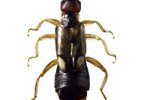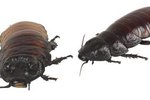
Gnats and fruit flies are small fly species that share many similar habits, such as consuming decomposing animal carcasses, and it is not quite easy to tell them apart. The two species' common names are colloquially used interchangeably, in error. In spite of the innumerable similarities between these two small flies, between them are myriad differences.
Body Size and Color
Whereas gnats are tiny insects, fruit flies or Drosophila are a bit larger and considerably conspicuous. The most common species of fruit flies measure about an eighth of an inch in length. They have slightly brownish heads and thoraxes, black tails and bright red eyes. By contrast, fungus gnats (Bradysia spp.) are wholly black in color and measure just a sixth of an inch in length. Nonetheless, their legs are long and gangly, and are very noticeable when they are flying.
Their Families
Fruit flies and gnats can be difficult to distinguish unless observed under a microscope; that notwithstanding, they belong to two distinct families within insect order Diptera, the true flies. By all accounts, fruit flies species are in thousands spread all over the world, and experts classify them under family Tephritidae. Gnats, meanwhile, are classifiable into different families, with fungus gnat falling under the family Sciariderae.
Habitat
Fruit flies are commonly fascinated by ripening fruits, and therefore it is no surprise to see them flying around such fruits. Females lay their eggs on rotting fruits and vegetables. On the other hand, gnats are mostly found in moist and damp places around which you are most likely to see them flying in large flocks or wavering "ghosts." Additionally, gnats are found around large bodies of water, above which they hover to absorb the carbon dioxide that is emitted by the algae.
Life Cycle
Fungus gnats lay their eggs on the soil in houseplants. In a span of four days, these eggs hatch into larvae, which then metamorphose into pupae. The pupal stage lasts for one week, after which they develop into full-grown adults. They have fairly short adult lives, lasting for just a week -- during which the females lay about 150 eggs. Once they emerge from their eggs, fruit fly larvae continuously depend on rotten matters for food. Females of fruit flies lay close to 500 eggs despite their fairly short life cycles.
References
Photo Credits
-
Brand X Pictures/Brand X Pictures/Getty Images
Writer Bio
Kendal Elizabeth has been a professional writer and editor since 2001. She has specialized in writing pet-related topics, home decor and gardening. Her work has appeared on several online and offline publication. Elizabeth holds a Bachelor of Science in Animal Science with a minor in marine biology from Cornell University.



